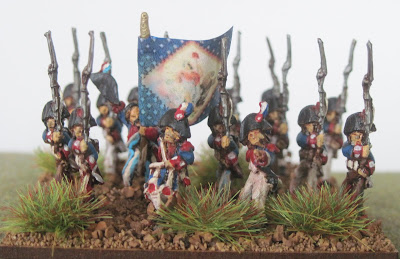Thinking about We Brought You Liberty brought to mind that crucial first fire. You know the theory. Far from the stress and danger of combat the battalion had carefully loaded its pieces. When the moment came it presented, leveled, and unleashed death. No subsequent fire would be as devastating. There were a few caveats.
For maximum effect you needed to deploy in line and pack your firers as closely together as practical. You also needed your enemy to come well within range, anything below 75 yards was good enough. Below 50 yards was ideal. For best results your enemy should be packed closely together too. This was because soldiers tended to point rather than aim their muskets. All those criteria being met a good outcome could be expected.
Much ink was expended as various theories contended on how to best deploy this decisive technology. Fire by platoon, section, file and battalion all had their advocates. All however agreed the first fire was the one that did most damage.
After that, most thought that rapid fire was needed. The soldiers might even ignore loading drill so long as they shot as quickly as they could. The aim was for maximum enemy disorientation after the lethal first fire. In other words, to prevent the foe from recovering from the first shock . As you may imagine misfires, clogged barrels and wide shots ensued. Officers didn’t mind as long as the lead kept flying.
There were keen eyed military dissenters. The most famous, perhaps, being Ney, who opined two volleys maximum and then in with the bayonet. His words were lost in the incessant clamor. A few years later the British did just that-with no small degree of success.
There was something else too. Once troops had begun firing it was very difficult to stop them doing so. It could continue until barrels were too hot to handle and ammunition ran out. Adrenalin and fear beat the cat.
It follows then that the first fire was to be avoided if possible. Armour could no longer mitigate it. Cover was useful but not always conveniently present.
Highlanders had liked to try to provoke first fire at a safe distance before their charge went in. They did this through aimed fire dropping individual opponents. Hopefully the victim’s comrades then fired back and then it was Claymore!
During the American Revolution the British learned the value of having their own light infantry to see off American provocative skirmishing aimed fire. Thus, they preserved the first fire of their line battalions for better, more closely packed, targets. That tactical advance that was swiftly forgotten. Not so by the French who took it to heart.
When the monarchs of Europe decided to crush the Revolutionary French, their instruments were linear armies using devastating fire power. The Prussians were the exemplar.
A Republican response was required. It came in the form of Cannon, Columns and massed skirmishers.
What trained troops the Republic had could form line with the best of them. The problem was most of their troops were not trained when the war began.
French artillery was good and plentiful and closely packed regimental lines made for fine targets for canister.
The dispersed masses of skirmishers using aimed fire made for poor targets. Yet they demanded a response.
Even barely trained men could form a column and move swiftly forward.
A column was mostly protected, by its front rank, from canister. What was needed was round shot that could plow through rank after rank. Accustomed to linear fights the guns of the Monarchists stuck to canister.
The French method was a viable trifecta of what was available to them and it saved the Revolution.
If politics is the art of the possible the same can be said of war. We can add to this that necessity is truly the mother of invention. That is not to say the Republican way of war was newly minted-for it was not. Rather, the theories of advanced French military thinkers were finally put into practice whole sale.
The results were spectacular.
The toys are all from Lancashire Games save for Blue Moon Grenadiers and some command figures. All Les Bleus are painted as the Parisian National Guard.




















